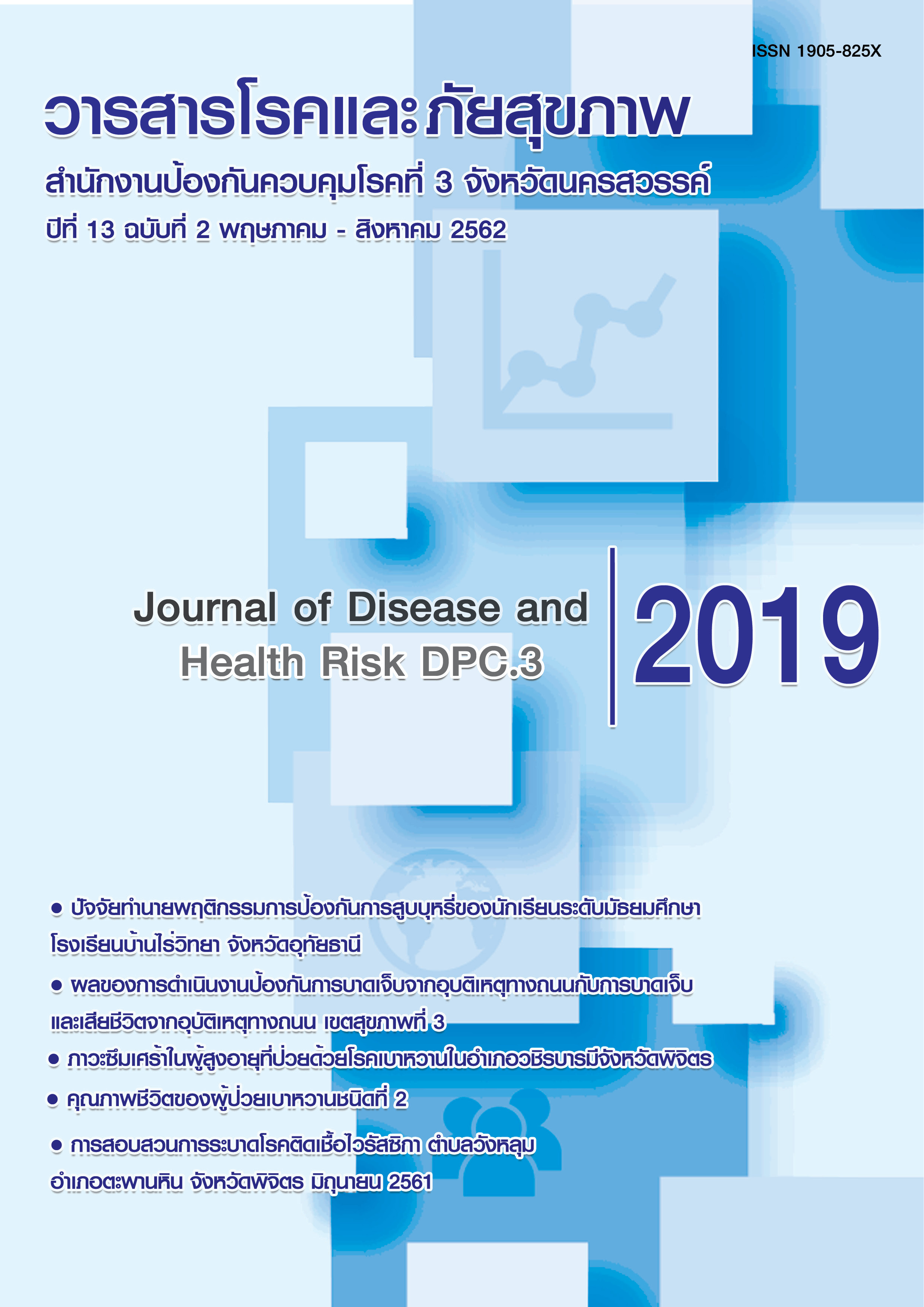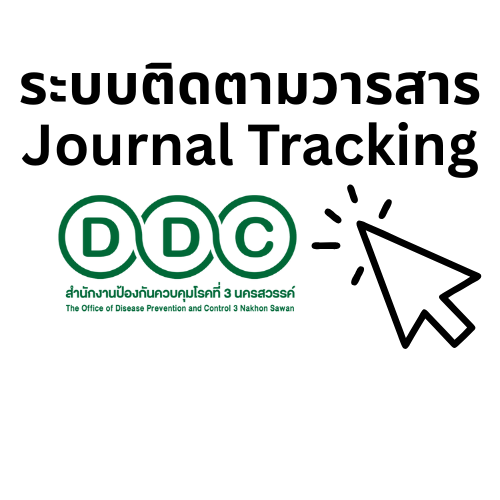Quality of Life of Patients with Type II Diabetes
Keywords:
quality of life, patients with type 2 diabetesAbstract
This study employed prospective descriptive study and purpose aimed to study the Quality of Life (QoL) of patients in type 2 diabetes (T2DM). The sample was 291 patients with T2DM who got treatment at DM clinic, out-patient department, Phrae Hospital, Phrae Province. A questionnaire consisted of two parts was used to elicit indices quality of life on participants including 1) Socio-demographic data and health profile; 2) The Thai version of a Diabetes Quality of life (Diabetes-39 Thailand) consisted of 39 items and one item of overall QoL. The reliability of the questionnaire was a Cronbach’ s alpha coefficient at 0.85. Data were analyzed using descriptive statistics.
Results showed that most of them were females with 62.54 % and aged more than 60 years with 54.64 %. Most patients (41.24 %) had BMI >25 kg/m2. Moreover, they had HbA1c > 7% with 57.73 %. The overall score of QOL was moderate (Mean=4.735, SD=1.380). The first health dimension affecting the QoL of the diabetes was Energy and mobility (EM): felt tired and fatigue in doing activities, problem of visual impairment. The second health dimension affecting the QoL was Diabetes Control (DC): uncontrolled diabetes consistently and consequences of diabetes related complications. Thus, healthcare professionals should assess health behaviors and functional health ability to detect factors related to fatigue of the diabetes. Moreover, the healthcare provider should monitor hemoglobin A1c and screen diabetic retinopathy. These activities can prevent consequences of diabetes related complications and also improve a quality of life of the diabetes.
References
International Diabetes Federation. IDF Diabetes Atlas 8thedition. [Internet]. 2017. [cited 2019 February 1]; Available from: http://diabetesatlas.org/resources/2017-atlas.html
สำนักงานนโยบายและยุทธศาสตร์ สำนักงานปลัดกระทรวงสาธารณสุข. รายงานประจำปี 2558. [อินเตอร์เน็ต]. 2558. [เข้าถึงเมื่อ 5 เมษายน 2561]. เข้าถึงได้จาก: http://thaincd.com/document/file/download/paper-manual/Annual-report-2015.pdf
ชัชลิต รัตรสาร. สถานการณ์ปัจจุบันและความร่วมมือเพื่อปฏิรูปการดูแลรักษาโรคเบาหวานในประเทศไทย. [อินเตอร์เน็ต]. 2560. [เข้าถึงเมื่อ 2 กุมภาพันธ์ 2562]. เข้าถึงได้จาก: https://bit.ly/2VwZxXF
Trikkalinou A, Papazafiropoulou AK. & Melidonis A. Type 2 diabetes and quality of life. World Journal of Diabetes 2017; 8(4): 120-129.
Timar R, Velea L, Timar B, Lungeanu D, Oancea C, Roman D, & Mazilu, O. Factors influencing the quality of life perception in patients with type 2 diabetes mellitus. Patients Preference and Adherence 2016; 10: 2471-2477.
กรมควบคุมโรค กระทรวงสาธารณสุข. สถิติข้อมูลโรคไม่ติดต่อเรื้อรังของสำนักโรคไม่ติดต่อจำนวนและอัตราตายโรคไม่ติดต่อประจำปี 2558. [อินเตอร์เน็ต]. 2558. [เข้าถึงเมื่อวันที่ 26 กุมภาพันธ์ 2562]. เข้าถึงได้จาก: https://bit.ly/2uWWfRN
คลินิกเบาหวาน แผนกผู้ป่วยนอก โรงพยาบาลแพร่. ข้อมูลผู้ป่วยเบาหวาน คลินิกเบาหวาน โรงพยาบาลแพร่ แพร่: โรงพยาบาลแพร่; 2561. (เอกสารอัดสำเนา)
Israel GD. Determining sample size. [Internet]. 2003. [cited 2019 February 1]. Available fromซhttps://www.tarleton.edu/academicassessment/documents/Samplesize.pdf
กรรณิการ์ สงรักษา และสงวน ลือเกียรติบัณฑิต. การพัฒนาแบบวัดคุณภาพชีวิตสำหรับผู้ป่วยเบาหวาน Diabetes-39. สงขลานครินทร์เวชสาร 2552; 2(1): 36-49.
ศิรินทิพย์ โกนสันเทียะ คุณภาพชีวิตผู้ป่วยเบาหวานโรงพยาบาลเฉลิมพระเกียรติสมเด็จย่า 100 ปี เมืองยาง อำเภอเมืองยาง จังหวัดนครราชสีมา. วารสารวิทยาลัยพยาบาลบรมราชชนนีนครราชสีมา 2554; 17(1):31-44.
Chentli F, Azzoug S, & Mahgoun, S. Diabetes Mellitus in elderly. Indian Journal Endocrinology and Metabolism 2015; 19(6): 744-752.
Murphy J, Chevalllier S, Gougeon R, Goulet EDB, & Morais JA. Effect of obesity and type 2 diabetes on protein anabolic response to insulin in elderly women. Experimental Gerontology2015; 69(9): 20-26.
Sami W, Ansari T, Butt NS, Hamid MR. Effect of diet on type 2 mellitus: A review. International Journal of Health Science 2017; 11(2): 65-71.
กระทรวงการพัฒนาสังคมและความมั่นคงของมนุษย์. เบี้ยยังชีพผู้สูงอายุ 2561. [อินเตอร์เน็ต]. 2561. [เข้าถึงเมื่อ 7 เมษายน 2562]. เข้าถึงได้จาก: https://phartrillion.com/allowance/
Kyrou I, Tsigos C. Obesity in the elderly diabetic patient. Diabetes Care 2009; 32 (Suppl 2): S403-S409.
Kalra S, Sahay R. Diabetes fatigue syndrome. Diabetes Therapy 2018; 9: 1421-1429.
สุวรรณี สร้อยสงค์, อังคณา เรือนก้อน, ขวัญสุวีย์ อภิจันทรเมธากุล, นิลุบล นันตา และจุฑามาศ สุขเกษม. พฤติกรรมการดูแลตนเองตามการรับรู้ของผู้ป่วยเบาหวานชนิดที่ 2 ที่ควบคุมระดับน้ำตาลในเลือดไม่ได้. วารสารวิทยาลัยพยาบาลพระปกเกล้า จันทบุรี 2560; 28(2): 93-103.
Jodar-Gimeno E, Alvarez-Guisasola F, Avila-Lachica L, Palomares-Ortega R, Roldan-Suarez C, & Lizan-Tudela L. Quality of life and fear for hypoglycemia in patients with type 2 diabetes mellitus. Revista Clínica Española 2015; 215(2): 91-97.
ณัฐพงศ์ เมฆาสิงหรักษ์, สิรินันท์ ตรียะเวชกุล, จีราวัฒน์ สวัสดิวิทยะยง, หญิง สุพัฒนวงศ์, ปณตศม เง่ายุธากร, อรณิชา พิมพะ, ฉัตรมงคล พรวนเจริญ และรสสุคนธ์ คชรัตน์. ความชุกและปัจจัยของภาวะเบาหวานขึ้นจอตาจากเบาหวานชนิดที่ 2 ในโรงพยาบาลส่งเสริมสุขภาพตำบล 6 แห่งในเครือข่ายโรงพยาบาลมหาวิทยาลัยนเรศวร, วารสารมหาวิทยาลัยนเรศวร: วิทยาศาสตร์และเทคโนโลยี 2558;23(3): 35-45.
American Diabetes Association. Standards of medical care in diabetes-2014. Diabetes Care 2014; 37(Supplement 1): S14-S77.
Downloads
Published
How to Cite
Issue
Section
License
Copyright (c) 2019 Journal of Disease and Health Risk DPC.3

This work is licensed under a Creative Commons Attribution-NonCommercial-NoDerivatives 4.0 International License.
Copyright notice
Article published in the Journal of Disease and Health Risk DPC.3 Nakhon Sawan. It is considered a work of academic research and analysis as well as the personal opinion of the author. It is not the opinion of the Office of Disease Prevention and Control 3, Nakhon Sawan. Or the editorial team in any way Authors are responsible for their articles.
Privacy Policy
Name, address and e-mail address specified in the Journal of Disease and Health Risk DPC.3 Nakhon Sawan. It is used for identification purposes of the journal. And will not be used for any other purpose. Or to another person.









